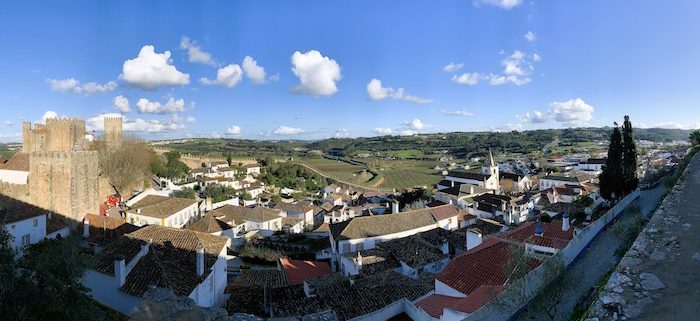Have you ever wanted to live in a fairytale village? Where the medieval, white-washed houses are encircled by castle walls and the ramparts overlook the countryside? A place where you can go everywhere on foot and there isn’t a car to be seen? Yes? Then bem-vindo to your lifestyle guide for Óbidos, the historic walled town known as the “Wedding Present Village”.
Brief History of Óbidos, Portugal
Óbidos is in the central region of Portugal known as the Silver Coast. The medieval village is around 88 kilometres (55 miles) from Lisbon and 138 kilometres (86 miles) from Coimbra.
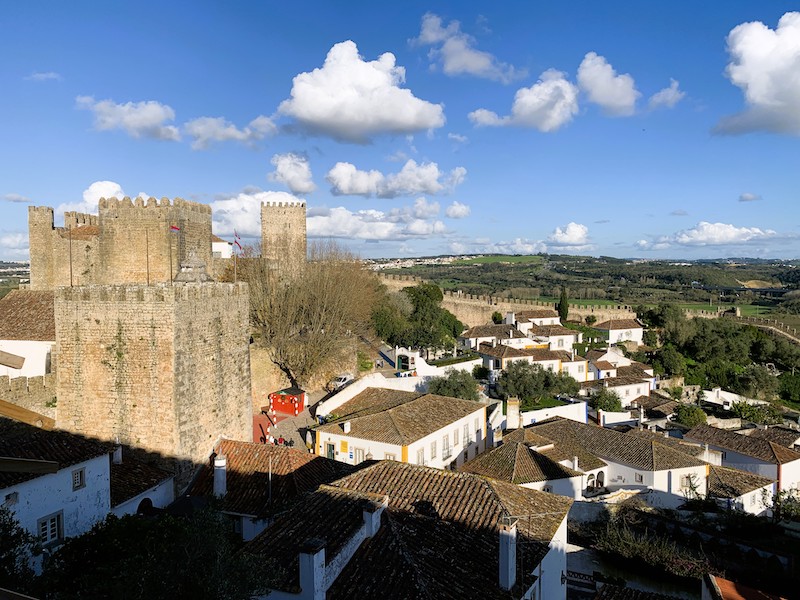
King Dinis gave to Queen Isabel on their wedding day in 1282, the lovely town of Óbidos. All Óbidos has been declared a national monument. The medieval Castle of Óbidos is a walled castle encircling the modern village. Portugal’s most romantic medieval village has incredibly picturesque cobblestone streets lined with white-washed houses adorned with colourful trim filled with geraniums and bougainvillea, Gothic doorways and windows, churches, flowerpots, and dazzling tiles—all encircled by the walls of a 12th-century castle. Scaling its 13 metre (45 foot)-high medieval walls is the best way to admire this picture-perfect place with 360-degree views of the tranquil countryside.
The history of Óbidos is a rich one. The place was inhabited by the Lusitanians until the Romans arrived. There, they built what would become the castle as an outpost for the Roman Legions. The Visigoths took over after. When the Muslims came in the 8th century, the outpost was turned into a city. A wall was built all around the settlement, and they fortified the Roman outpost, turning it into a castle.
This era ended in 1148, when Afonso Henriques, the first king of Portugal, conquered it and integrated the town into its kingdom. From then on, the village was part of the dowry for various Portuguese queens, such as Queen Catherine, who would build the town’s aqueduct.
What to Do in Óbidos, Portugal
Forget the rest of the world—that’s what you do in Óbidos.
Park your car anywhere outside the walls where your car will fit and walk through a gate to enter a new land. The town is small enough it doesn’t matter where you enter since the streets are incredibly walkable. There is a large, free parking lot, but we found a place outside the walls before we discovered the parking lot. Don’t waste your time driving around outside the walls of the town. Park, get out and walk.
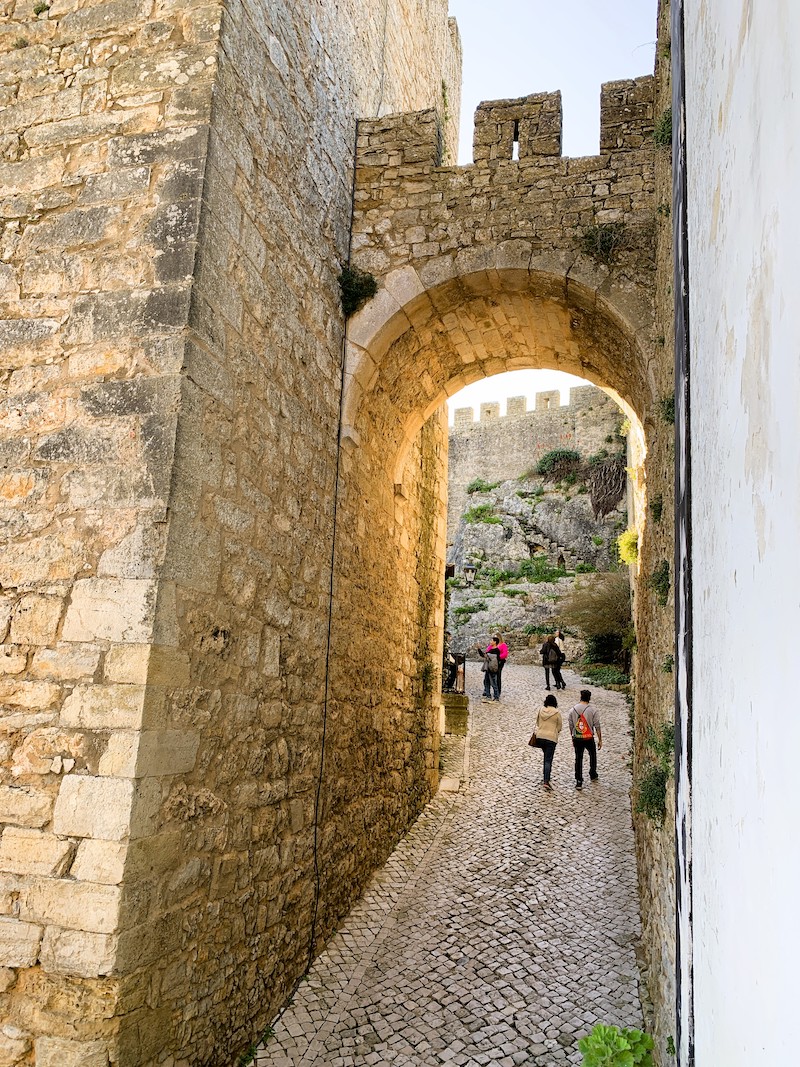
I have lived in a tourist town, and this advice goes to anyone wanting to visit or live… avoid the crush of summer tourists by visiting Óbidos in the spring or fall. We visited in January, and the town was busy but not overrun.
Experience the Insider community that takes your international lifestyle to the next level. Download your FREE guide
"18 Steps to Implementing Your Plan B" instantly!
Walk the Walls
The walls surrounding the town are one of its main attractions. Its perimeter is 1.565 metres (5,134 feet), surrounded by a walking path on one side and a battlement on the other. The walls were defended by towers you can see throughout the town. Be careful walking the walls as there are no handrails, and there have been incidents of people falling. It’s a good idea to buy travel insurance, especially if you are a digital nomad, to protect you in case a situation arises.
Walk the Medieval Streets
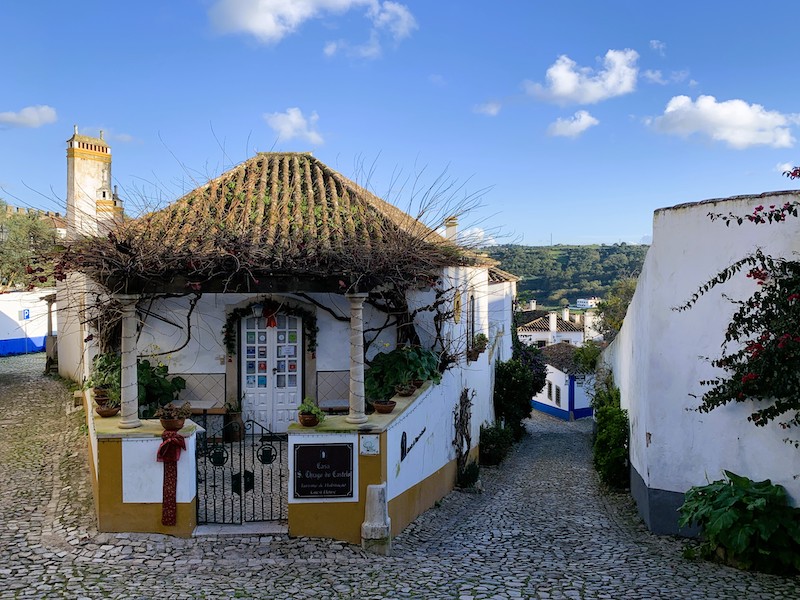
As you walk in this town, become enchanted with live music, crooks and crannies offering restaurants, Ginja and chocolate tastings, clothing, antiques, wines, souvenirs, and sprinklings of knights in armour to set the scene. Since Óbidos is a tourist highlight in Portugal, many locals speak English. If you are game to immerse yourself in the culture, try to learn Portuguese before you go.
Explore Saint Mary’s Church and Square
When King Afonso I Henriques recaptured Óbidos from the Moors, he built a church on the main square. Saint Mary’s Church is the main church in Óbidos. Though much of it has been destroyed over the years, the structure has been reconstructed, and the inside is covered with beautiful tiles.
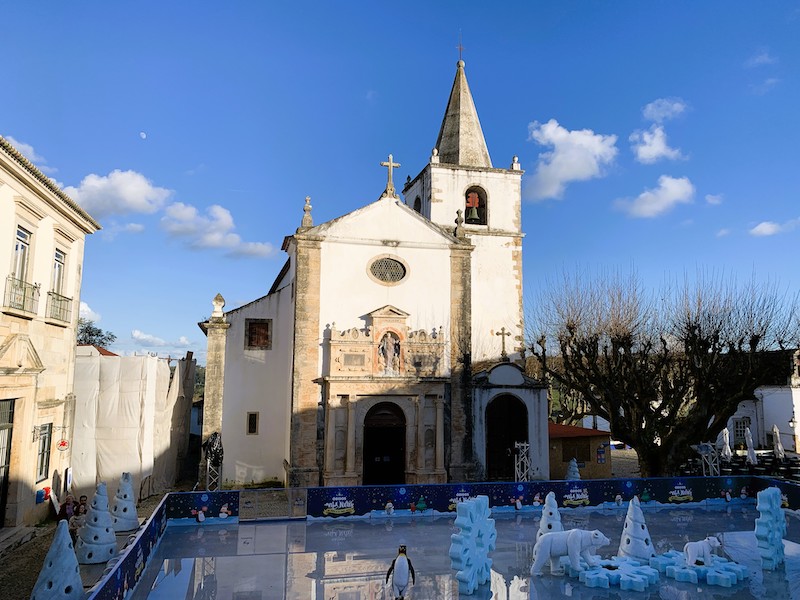
Spend time exploring the square, where a pillory (a device made of a wooden or metal framework erected on a post, with holes for securing the head and hands) was used to humiliate and punish criminals in the 15th century.
Sample Ginja
Ginja and all forms of any way you can consume this Portuguese liqueur are on nearly every corner. Served with hot chocolate or in chocolate one-ounce cups consumed after the super sweet sour cherry liqueur warms your throat. The sweet delight will only set you back €1.50. The oldest record of Ginja’s existence dates to the 1st century. It was in the 17th century when the priests of Óbidos began to use these fruits to make the beloved drink we all know today.
Try the Codfish Cake: More than a Mere Snack
“It is the voice of the land yearning for the sea” from a poem D. Dinis, by Fernando Pessoa.
Salted cod is extremely popular and traditional in Portugal and is usually served with Port; in Óbidos, it is served with Ginja. Sweet and salty anyone? A scaled and open fish, curing salt, sun, and weather is the secret behind this Portuguese icon. The simplicity of the preservation of the fish characterizes the Portuguese people. You will see salted cod (and smell it) in all the grocery stores as it is one of the most traditional fish consumed in Portugal. For my palate, I did not find it a delight on its own, but the “Pastel” as it’s known in the south and the “Bolinho” as it’s known in the north, blends beautifully with potato, egg, parsley, codfish, and olive oil into a large, round crisp, salty, savoury, melt-in-your-mouth morsel stuffed with PDO Serra da Estrela cheese, a divine cheese, with 1300 years of history and protected designation of origin. The protected designation of origin (PDO) is a type of geographical indication of the European Union and the United Kingdom aimed at preserving the designations of origin of food-related products.
The delicate dumpling is a way to bring the sea to the interior of Portugal by celebrating two icons of Portuguese gastronomy—the cod pastry and PDO Serra de Estrela cheese. The cheese is from the highest mountain range in Portugal, Serra de Estrela. The art of transforming sheep’s milk into cheese like no one else, to which only thistle flower and salt are added with the fundamental ingredient: soul. Named one of the 7 Wonders of Gastronomy in Portugal in 2011, it is now widely recognized as one of the most extraordinary cheeses in the world, but it has a long history. It is the oldest of all Portuguese cheeses with a buttery texture and is 100 percent natural, with an incredibly smooth, clean, and slightly acidified bouquet.
Have the full experience with your cod pastry and sit down in the area where you can watch the experts create the pastels by hand and listen to live violin music pour over the rafters and through the room right into your heart. Your fresh baked, hot pastel in your hand and a glass of Ginja in the other is a true Óbidos experience. Your tastebuds will sing a hallelujah.
The man working behind the counter at Casa Portuguesa do Pastel de Bacalhau recognized my husband’s CFL (Canadian Football League) jacket. If you are from Saskatchewan, Canada, you will get what I am about to say. Green is the colour, and football is the game. Green Rough Riders’ paraphernalia is everywhere. No matter where we have travelled, we run into a Saskatchewan Rough Riders football team fan or foe. The team is a tradition sewn into the fabric of the Saskatchewan Prairies. Back to Óbidos.
The man was native to Portugal and had been to Canada. He visited Toronto and Montreal (as most foreigners we meet do). We usually hear how much people love Canada and Canadians, how beautiful the country is, and so on. This man had a different take. He was not rude but merely stated a fact, “I have no reason to return to Canada.” He was glad to have visited, but the weather and cost of living were not to his taste. He loved to travel, and his next destination of choice was Vietnam. He visited Thailand and loved it. The food, the people, the low cost of living. It was a breath of fresh air to talk with someone so honest about his experiences in our home country. Every country has its pluses and minuses. That’s why it is so important to go and see for yourself.
Become One with Medieval Portugal
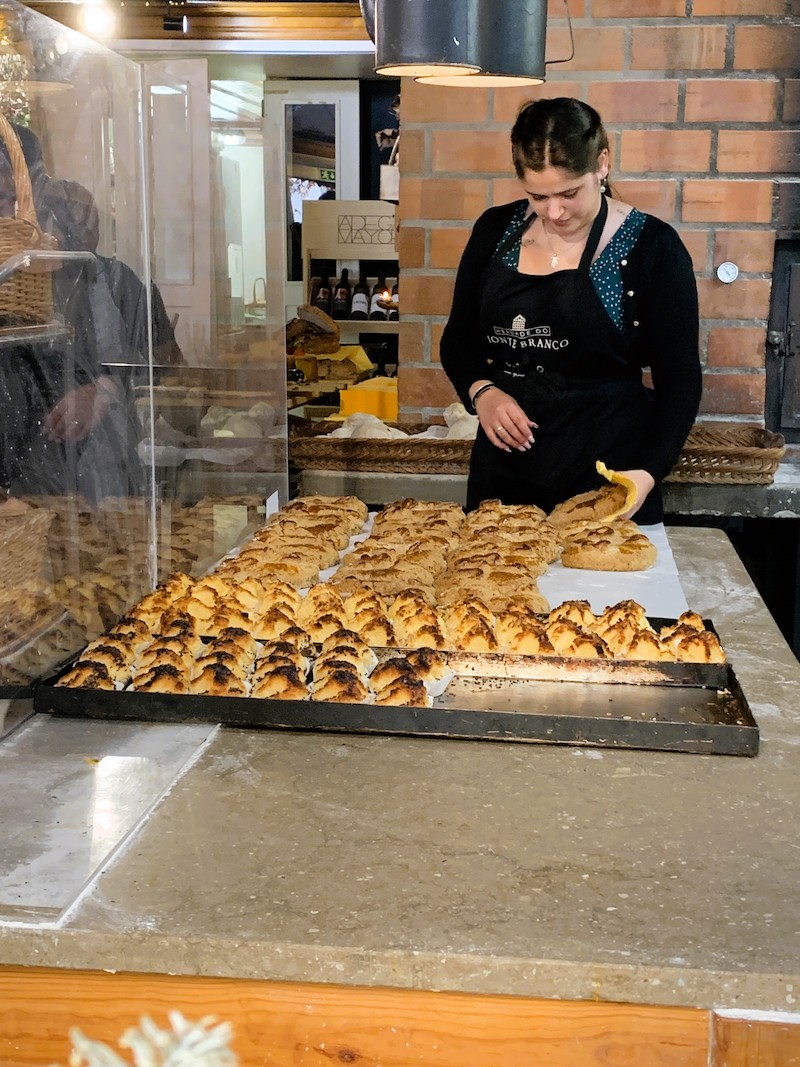
The best thing you can do in Óbidos is relax, listen to live music around the streets and soak up the culture, smell the wood-burning fireplaces, marvel at the pastries in bakery windows, enjoy the architecture, and admire the traditional blue and white hand-painted Portuguese tiles called azulejo.
The Village Door, or “Porta da Vila”, is the main entrance to the interior of the walled city. The door was built in 1380, and it’s adorned with the beautiful Portuguese azulejos, with an engraving dedicated to the Virgin Mary for her protection during the Restoration of Independence in 1640.
Books outnumber residents in Óbidos. Over more than half a million books adorn unique bookstores. Bibliophiles delight in the Grande Livraria de Santiago, located in the 13th-century Church of Santiago.
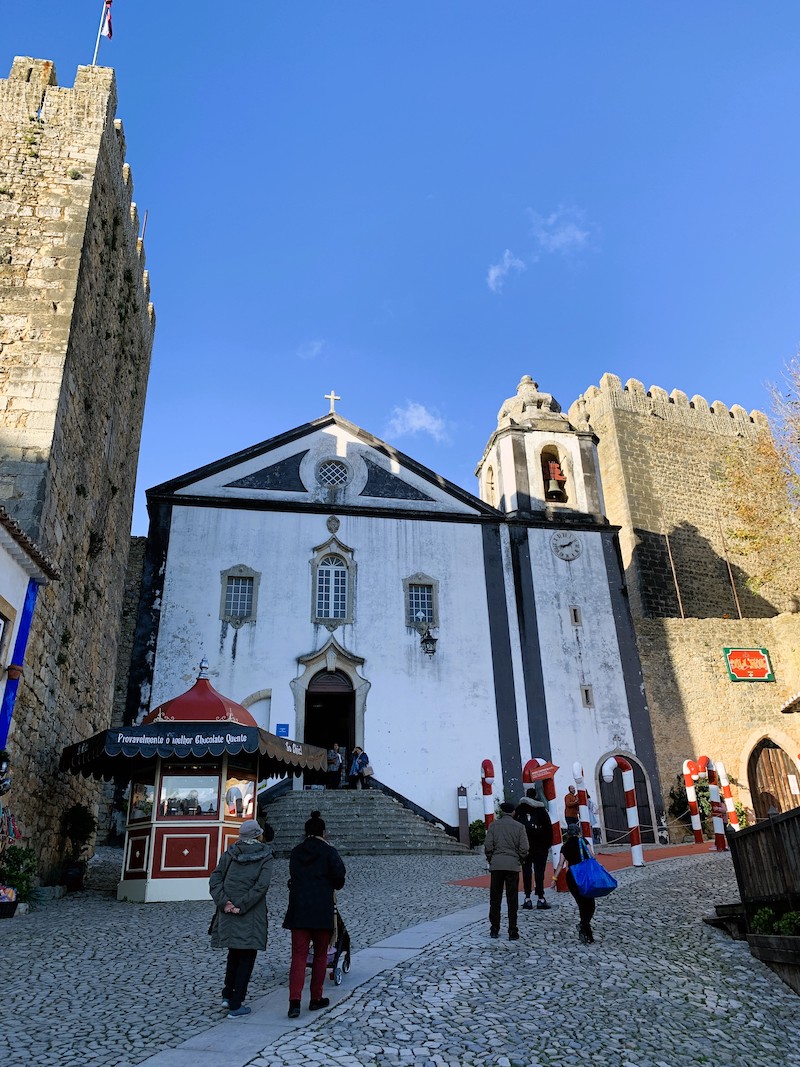
Grande Livraria de Santiago
So, we have covered what a sweet and salty day can be like in Óbidos, but what about living there? Do you think it would be expensive to live in a modern-day museum? Is the fairytale lifestyle within everyone’s reach?
Living in Óbidos
Óbidos is a tourist area, so not many people live in the village. The people who live in the Óbidos village tend to be people who inherited their property. They keep to themselves and are exceptionally quiet, which seems to be typical for tourist towns.
Óbidos is a great place to visit or live if you are a remote worker. If you want more of a social life, move to Caldas, which is five minutes away.
Population
The village has a population of approximately 3,100 inhabitants, while the municipality population in 2021 was 12,410. If you want to live in a small town full of life, look at Óbidos and the surrounding area. The highest average age class is 45-54, and the municipality population has been increasing over the years.
Weather
If you like seasons, Óbidos may be for you. Summers are warm and mostly sunny, with daytime highs around 27°C (80°F), while in the winter rainy season, the temperature stays around 16°C (60°F).
Safety
The Global Peace Index for 2023 ranks Portugal as the seventh safest country in the world. A composite index measuring the peacefulness of countries made up of 23 quantitative and qualitative indicators each weighted on a scale of 1-5. The lower the score, the more peaceful the country. Portugal has a score of 1.333. The safest country in the world on the ratings is considered to be Iceland, with a score of 1.124.
Healthcare
Local healthcare is available, and you can choose from a variety of nearby hospitals located in Nazaré, Caldas da Rainha, Alcobaça, and Lisbon.
Festivals
festivals bring new life to the village several times a year. Springtime brings the International Chocolate and Pastry Festival, where chefs create marvellous chocolate sculptures. In July, the Medieval Market transports the populace back in time with authentic music, games, food, and animals. Listen to bagpipes, watch jousting, eat roast pig, and watch a camel caravan in one afternoon. In December, enter the castle grounds to quaff wine and ale, sample delicious food, and enjoy shopping for handmade crafts.
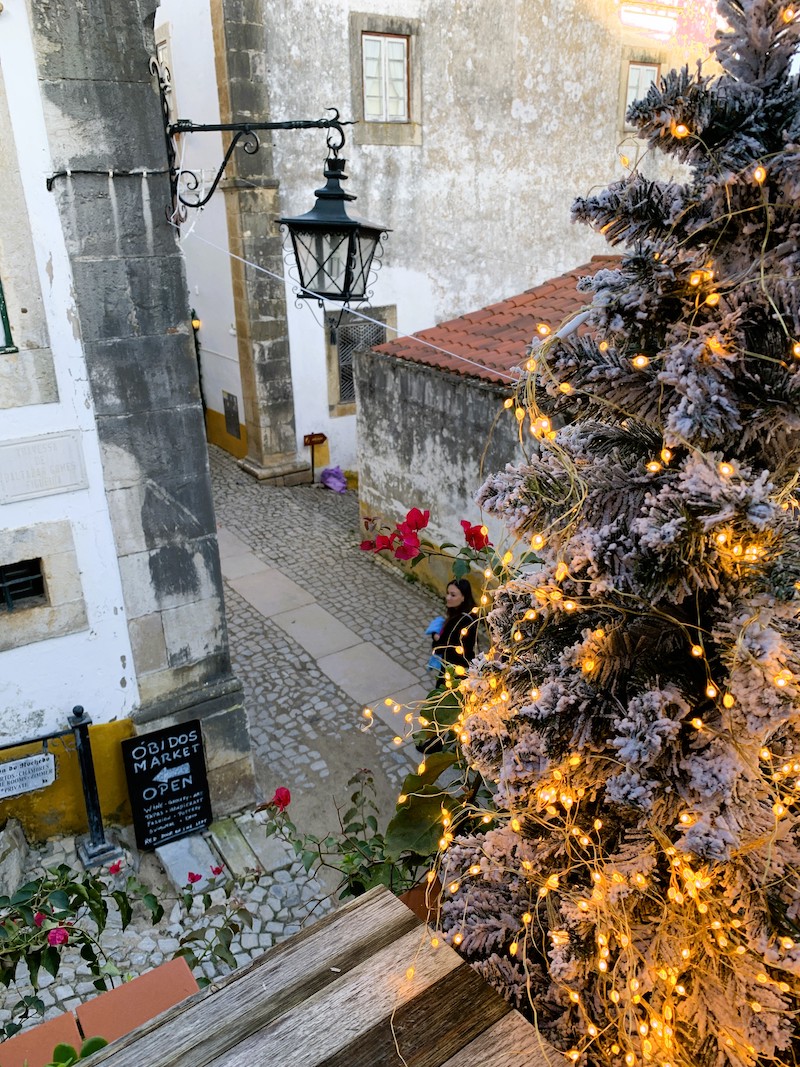
Cost of Living
Portugal is considered one of the most affordable countries in Europe. The cost of living is all relative to lifestyle. According to WorldData.info, Portugal is ranked 35 out of 102 countries for the cost of living and purchasing power related to average income, so a little higher than the mid-range. Canada ranks 16, and the United States ranks 17 on the list, meaning Canada is more expensive to live in than the U.S. Monthly income in Portugal averages USD$2,150.
Houses in the Silver Coast area can be anywhere from €70,000 to €1 million. The price, of course, depends on where you buy, the amenities, and the size of the house. Property prices on the Silver Coast have been increasing over the last few years.
When we visited Óbidos, the costs of food and supplies were comparable to the rest of Portugal.
A meal in a budget restaurant for two people will cost €12, a mid-range restaurant €50 for three courses. Groceries can run an average of €500 a month. Fuel averages €1.90, which is consistent throughout the country. A one-bedroom apartment in the city centre will run €1,200 and outside the centre €788. A three-bedroom apartment inside the centre will be €2,100, outside the centre, you’re looking at €1,300. Utilities average €127 a month (electricity, heating, garbage, water). Internet is €36. The prices here were as of August 9, 2023. Finding a place to live inside the village would be challenging due to its small size. For detailed and current price comparisons, check here.
Óbidos, Portugal: Your Fairytale Lifestyle
If you are a small-town girl like me, you will love Óbidos. I like to visit big cities but prefer the lifestyle of smaller towns. The attitude is laid back, and the authenticity of the destination hasn’t eroded under the modernity of a big city. Perhaps Óbidos can be your home away from home.
For deep, personal stories of Charlotte’s real-life expat lifestyle adventures and writers living the actuality of an international freedom lifestyle, subscribe to Escape Artist Insiders magazine today!
This post contains affiliate links. This means we will earn an affiliate commission if you click and/or make a purchase through the link (at no extra cost to you).
All photos provided by Charlotte Tweed
 Charlotte Tweed is an adventurous soul with a goal to take you on a journey where you don’t just visit—you live it. Graduating with a Travel and Tourism Honours diploma, Charlotte began her expat journey on June 15, 2021. After travelling through multiple countries, Charlotte now calls Mexico home. Reading, writing, and researching the best expat destinations in the world are how she fills her days. As a published author, her mission is to transform your life with expat travel—one destination, one adventure, one story at a time.
Charlotte Tweed is an adventurous soul with a goal to take you on a journey where you don’t just visit—you live it. Graduating with a Travel and Tourism Honours diploma, Charlotte began her expat journey on June 15, 2021. After travelling through multiple countries, Charlotte now calls Mexico home. Reading, writing, and researching the best expat destinations in the world are how she fills her days. As a published author, her mission is to transform your life with expat travel—one destination, one adventure, one story at a time.
Like Our Articles?
Then make sure to check out our Bookstore... we have titles packed full of premium offshore intel. Instant Download - Print off for your private library before the government demands we take these down!

